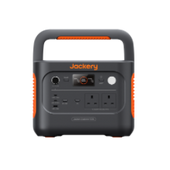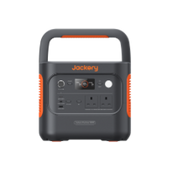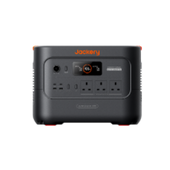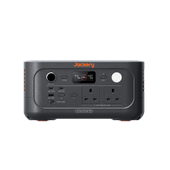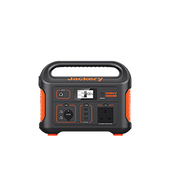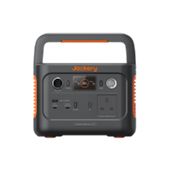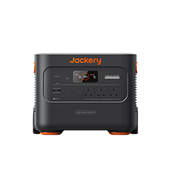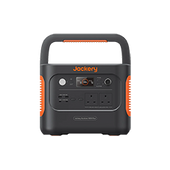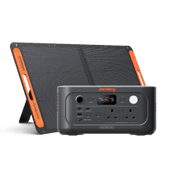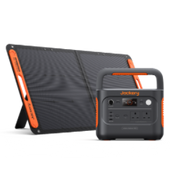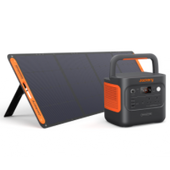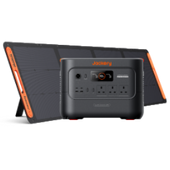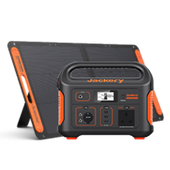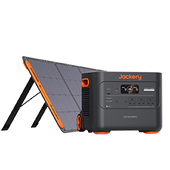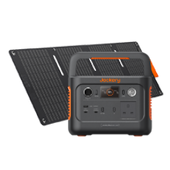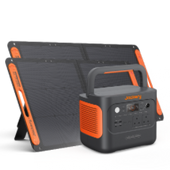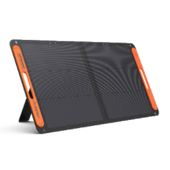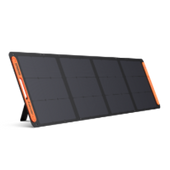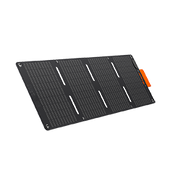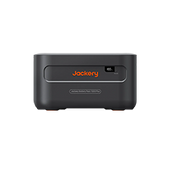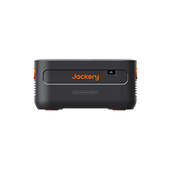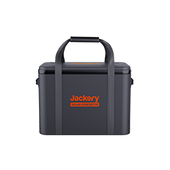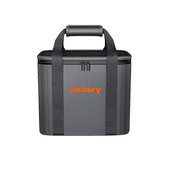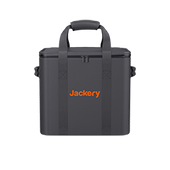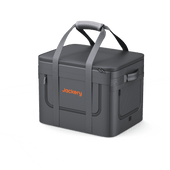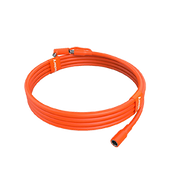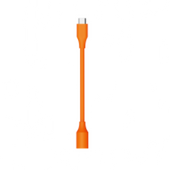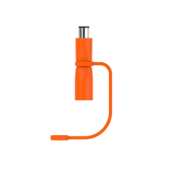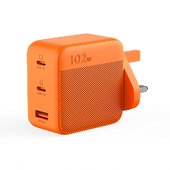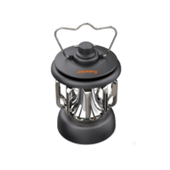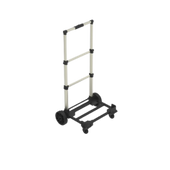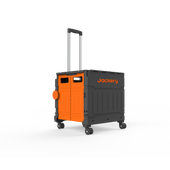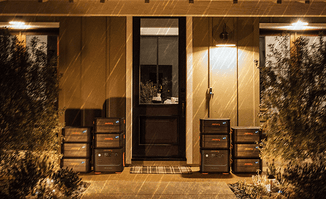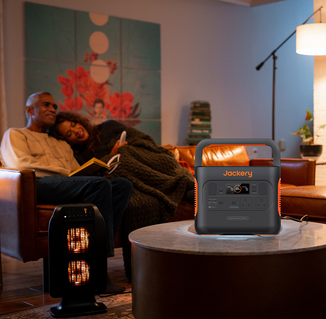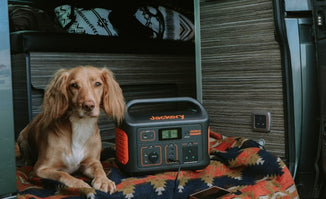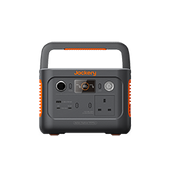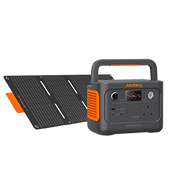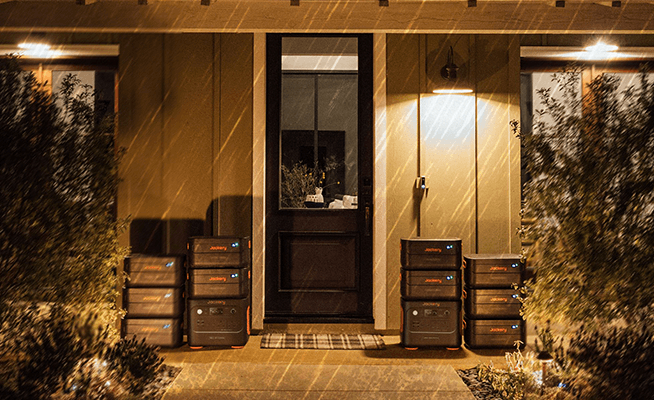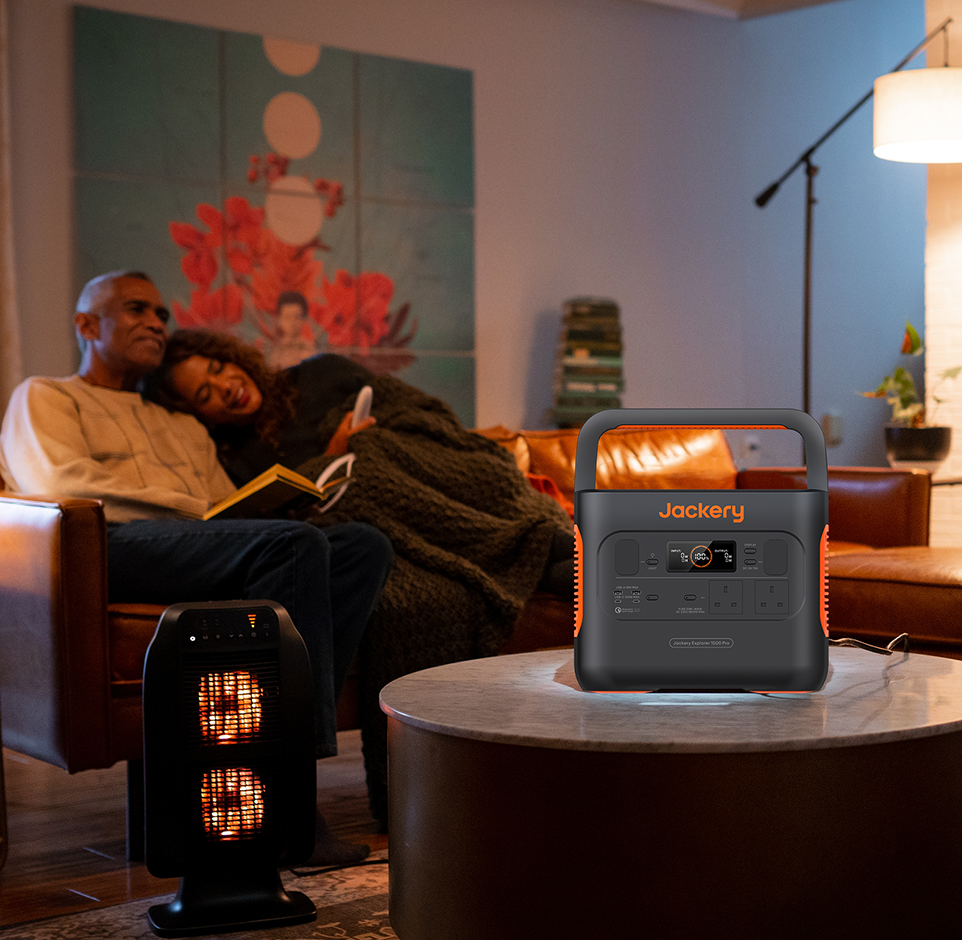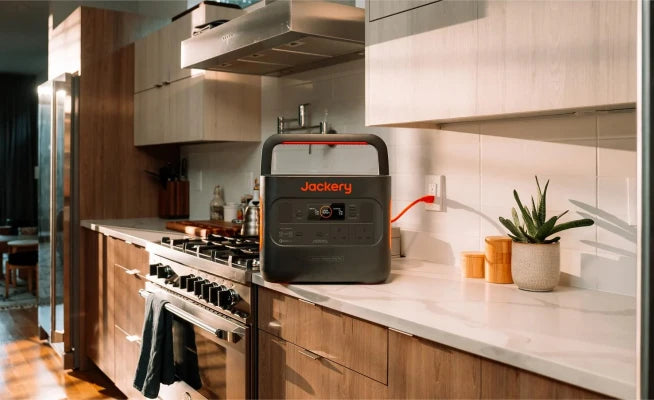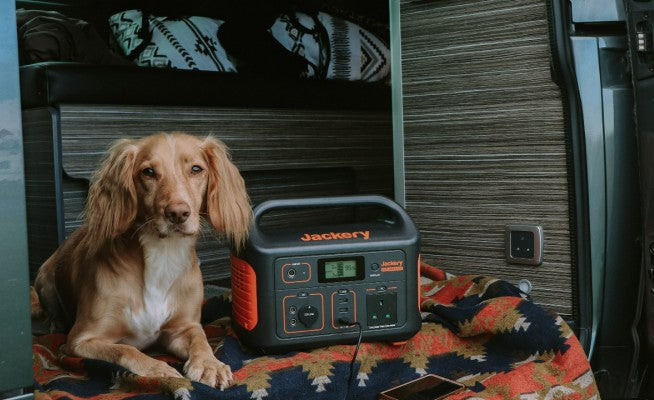LiFePO4 VS Lithium-Ion Batteries: Which One Is Right for You
Lithium-ion and LiFePO4 batteries are two popular battery types used in solar generators and power stations. While lithium-ion batteries have been commonly used in off-grid solar power systems for years, LiFePO4 batteries have recently gained popularity.
Li-ion and LiFePO4 batteries have significant advantages, making them ideal for backup power stations. In this guide, we'll walk you through the LiFePO4 vs. lithium-ion comparison in detail, so you can understand which battery backup suits your needs.
Jackery manufactures a wide range of solar generators, ranging from a lithium-ion battery of 240Wh to 2160Wh capacity. The Jackery Explorer 2000 Plus Portable Power Station features a LiFePO4 battery that can be expanded from 2kWh to 12kWh using the Battery Pack 2000 Plus.
 |
|
| - Expandable battery capacity from 2kWh to 12kWh. - Long LiFePO4 battery life of up to 4000 charge cycles. - Powers heavy-duty electrical devices up to 6000W - Efficiently charges up to 99% of home or outdoor appliances. - Works silently with less than 30dB of noise. |
What Is A LiFePO4 Battery?
LiFePO4 (or lithium iron phosphate) batteries are a subtype of rechargeable lithium-ion batteries that utilize unique chemistry to provide advantages over lithium technologies.
The cathode of LFPs is made from lithium iron phosphate (LiFePO4), whereas the anode is typically made from carbon. Since LiFePO4 does not contain cobalt, they are a more eco-friendly choice.
Pros
- LiFePO4 is a safe and stable rechargeable battery due to lithium iron phosphate's high thermal and structural stability.
- They have a longer lifespan, making these batteries cost-effective in the long run.
- They do not contain any hazardous materials, making them more eco-friendly.
Cons
- LiFePO4 batteries have a low nominal voltage that reduces energy.
- They have a higher price compared to other batteries.
LiFePO4 Summary Table
|
Voltage |
Nominal voltage: 3.20 to 3.30V Typical operating range: 2.5 to 3.65V per cell |
|
Specific Energy (or Capacity) |
90 to 120 Wh/Kg |
|
Charge (C-rate) |
1C typical charges to 3.65V Typical charge time: 3 hours |
|
Discharge (C-rate) |
1C, 25C on some cells, 40A pulse (2s) Cut-off (lower than 2V causes damage): 2.50V |
|
Cycle life |
2000 and higher |
|
Thermal runaway |
270°C (518°F) Highly safe battery even when charged fully |
|
Applications |
Electric vehicles, solar generators, portable power stations, etc. |
What Is A Lithium-Ion Battery?
Lithium-ion batteries are commonly used in power stations and sensitive electronic devices like laptops, cameras, and mobile phones. They have high energy storage capabilities and comparatively lower self-discharge rates.
These batteries also include three essential components: an anode, a cathode, and an electrolyte. What differentiates lithium-ion from LiFePO4 is the cathode made of lithium metal oxides.
Pros
- Li-ion batteries have a longer lifespan than typical lead-acid batteries.
- The Li batteries can store large amounts of energy in relatively less space.
Cons
- Lithium-ion batteries without BMS (Battery Management System) may catch fire.
- They are more costly compared to other types of batteries.
Lithium-Ion Battery Summary Table
|
Voltage |
Nominal voltage: 3.60 to 3.70V Typical operating range: 3.0 to 4.2V per cell |
|
Specific Energy (or Capacity) |
150 to 220 Wh/Kg |
|
Charge (C-rate) |
0.7-1C typical charges to 4.20V or 4.30V Typical charge time: 3 hours |
|
Discharge (C-rate) |
1C, 2C on some cells Cut-off (lower than 2V causes damage): 2.50V |
|
Cycle life |
1000 to 2000 and higher |
|
Thermal runaway |
210°C (410°F) High charge to promote thermal runaway |
|
Applications |
Electric vehicles, solar generators, e-bikes, portable power stations, etc. |
LiFePO4 Vs. Lithium-Ion Batteries
Lithium-ion and LiFePO4 batteries are widely used in solar generators and power stations. While both are safe and secure battery types, some differences set them apart. Let's compare lithium-ion vs. LiFePO4 below.
|
|
LiFePO4 Battery |
Lithium-Ion Battery |
|
Chemistry |
Lithium, iron, and phosphate |
Metallic lithium and cathode materials, such as nickel, manganese, and cobalt |
|
Energy Level (Density) |
Lower |
Higher |
|
Safety |
Highly Safe |
Highly Safe |
|
Charging & Discharging |
The self-discharge rate is around 3% per month |
The self-discharge rate is about 5% per month |
|
Lifespan |
2000-6000 life cycles |
800-1000 life cycles |
|
Temperature |
-4°F (-20°C) to 140°F (60°C) |
32°F (or 0°C) to 113°F (or 45°C) |
|
Voltage |
Lower voltage |
Higher voltage |
|
Weight |
Heavier |
Lighter |
|
Warranty |
Depends on brand |
Depends on brand |
|
Applications |
Solar batteries, electric vehicles, recreational vehicles, and more. |
Phones, battery backups, and other small rechargeable devices. |
Let's dig deeper into each parameter and compare LiFePO4 vs lithium-ion.
Chemistry
LiFePO4 batteries consist of lithium, iron, and phosphate ions, making them relatively safer, more stable, and lighter than conventional ones. In contrast, Li-ion batteries contain metallic lithium and composite cathode materials like nickel, cobalt, or manganese.
Energy Level (Density)
Lithium-ion batteries generally have higher energy density than LiFePO4. That means Li-ion batteries can store more power and have long-lasting battery life. On the contrary, LiFePO4 is also suitable for backup power with high safety and extended life.
Safety
LiFePO4 is less prone to exploding and overheating, making them highly safe. By contrast, lithium-ion batteries without BMS or protective algorithms can catch fire or overheat when not used properly. However, lithium-ion batteries with battery system management are highly safe for solar power systems.
Charging & Discharging
The state of charge of a lithium-ion battery varies significantly depending on the voltage. In contrast, the SoC level of LiFePO4 is not easily distinguished by voltage level.
For this reason, it is easy to understand the accurate SoC of lithium-ion batteries, whereas calculating the SoC accuracy of lithium-iron phosphate batteries is challenging.
|
|
NCM |
LFP |
|
Charge-Discharge Rate |
 |
 |
|
SOC Estimation |
It is possible to accurately diagnose SoC. |
It is challenging to diagnose the exact SoC by its voltage. |
|
Accuracy in SOC Diagnosis |
±1~2% |
±10% |
|
Upper Voltage Limit |
4.2 |
3.6 |
Lifespan
Both Li-ion and LiFePO4 batteries are known for their long lifespan. Generally, the lifespan of NMC lithium-ion batteries is 800-1000 times, whereas LiFePO4 battery cycle life is over 6000 times.

Temperature
The operating temperature range of LiFePO4 battery backups is more comprehensive than Li-ions. Lithium-iron phosphate batteries can efficiently operate in cold and hot environments without power loss.
Voltage
The voltage directly impacts the design of battery packs and device voltage requirements. Typically, LiFePO4 batteries have a low nominal voltage of 3.2V per cell compared to Li-ion, with a nominal voltage of 3.6-3.7V per cell.
|
Lithium-ion Charge Capacity (%) |
1 Cell |
12 Volt |
24 Volt |
48 Volt |
|
100 |
3.40 |
13.6 |
27.2 |
54.4 |
|
90 |
3.35 |
13.4 |
26.8 |
53.6 |
|
80 |
3.32 |
13.3 |
26.6 |
53.1 |
|
70 |
3.30 |
13.2 |
26.4 |
52.8 |
|
60 |
3.27 |
13.1 |
26.1 |
52.3 |
|
50 |
3.26 |
13.0 |
26.0 |
52.2 |
|
40 |
3.25 |
13.0 |
26.0 |
52.0 |
|
30 |
3.22 |
12.9 |
25.8 |
52.5 |
|
20 |
3.20 |
12.8 |
25.6 |
51.2 |
|
10 |
3.00 |
12.0 |
24.0 |
48.0 |
|
0 |
2.50 |
10.0 |
20.0 |
40.0 |
|
LiFePO4 Capacity |
12V |
24V |
48V |
|
100% Charging |
14.6 |
29.2 |
58.4 |
|
100% Resting |
13.6 |
27.2 |
54.4 |
|
90% |
13.4 |
26.8 |
53.6 |
|
80% |
13.3 |
26.6 |
53.1 |
|
70% |
13.2 |
26.4 |
52.8 |
|
60% |
13.1 |
26.1 |
52.3 |
|
50% |
13.0 |
26.1 |
52.2 |
|
40% |
13.0 |
26.0 |
52.0 |
|
30% |
12.9 |
25.8 |
51.5 |
|
20% |
12.8 |
25.6 |
51.2 |
|
10% |
12.0 |
24.0 |
48.0 |
|
0% |
10.0 |
20.0 |
40.0 |
Weight
Compared to lithium-ion batteries, LiFePO4 tends to be heavier due to its lower energy density. However, the exact weight of the battery will depend on its capacity and size. For instance, a battery with a large capacity and size is heavier.
Warranty
The warranty of the LiFePO4 or lithium-ion will depend on the brand you choose. For instance, Jackery is the leading global solar brand manufacturer that manufactures high-quality power stations with LiFePO4 and lithium-ion batteries. Most power stations have 5 years of warranties, ensuring you can use them for years to come.
Applications
The lithium-ion battery is generally used in laptops, mobile phones, cameras, and portable power stations. These batteries can store power space and have a low self-discharge rate. LiFePO4 batteries have higher capacity and are generally used in solar or wind power systems.
The Lithium Batteries VS Other Batteries
Thanks to their features and long lifespan, lithium batteries are becoming more popular than ever. Different types of lithium batteries have their own benefits and drawbacks.
- Lithium Iron Phosphate:These batteries have phosphate as the cathode and carbon as an anode. They have a long lifecycle with good electrochemical performance and thermal stability.
- Lithium Cobalt Oxide:They have high specific energy and can deliver power over a long period.
- Lithium Manganese Oxide: With a three-dimensional structure, the LMO batteries have lower internal resistance and higher current handling.
- Lithium Nickel Manganese Cobalt Oxide: NMC batteries feature nickel, manganese, and cobalt. They have higher energy density with a longer life cycle.
- Lithium Titanate: These batteries have lithium titanate in the anode and LMO or NMC as a cathode. They are highly safe and charge faster than other lithium batteries.
- Lithium Nickel Cobalt Aluminium Oxide:NCA batteries can deliver a high amount of current for extended periods, as they have a high specific energy.

There's no doubt which battery wins the LiFePO4 vs. lithium-ion battle, as both batteries stand neck to neck. But how do lithium-ion batteries differ from other batteries?
- Lead-Acid Batteries:While these batteries might look like an affordable solution initially, they'll cost you more in the long run. They involve high maintenance costs and have less lifespan than lithium-ion batteries.
- Gel Batteries:What differentiates gel batteries from lithium-ion is their charging speed. Unlike Li-ions, gel batteries charge slower.
- AGM Batteries: When the battery reduces to 50% capacity, its chances of getting damaged increase. Alternatively, lithium batteries discharge without any risk.
- Deep Recycle Batteries: These small and lightweight batteries may not be able to provide enormous power bursts like lithium.
Jackery Portable Power Station Explained
Jackery is a leading solar brand manufacturing quality solar generators, solar panels, and power stations. Most of the Jackery battery backups for homes have in-built lithium-ion batteries.
They are safe and can supply stable electricity to small and large appliances. Jackery also offers an expandable Jackery Explorer 2000 Plus Portable Power Station with a LiFePO4 battery.
Jackery Explorer 2000 Pro Power Station
Jackery Explorer 2000 Pro Power Station features a lithium-ion battery with a long lifecycle of 1000 cycles, after which it will work at 80% capacity. The battery capacity of 2160Wh and a power output of 2200W can seamlessly charge 96% of your home or outdoor appliances.v
Customer Review
Got two of these Jackery 2000 Pro for the California (Sacramento area) blackouts. This is one of the best portable power stations as it could easily handle the surging demand for my A/C + two fridges during the outage. Highly recommend it. — S Wong.
Jackery Explorer 2000 Plus Power Station
Jackery Explorer 2000 Plus Power Station has an in-built LiFePO4 battery that can quickly expand from 2kWh to 12kWh. You can add 5 Jackery Battery Pack 2000 Plus to Explorer 2000 Plus to improve its capacity and capabilities. It has multiple output ports can charge 99% of your home appliances.

Customer Review
The 2000 plus uses LifePO4 cells which are safer and electrical safety is paramount for RVing. It is also rated for 4000 cycles, 4x more than the older Explorer 1000. The new one can also be expanded to an eye-whopping 12KWH coupled with the 30Amp output. It's enough to run the camper's AC for a few days if we ever want to invest in that much power. — Tech Connect.
|
|
Explorer 2000 Pro |
Explorer 2000 Plus |
|
Capacity |
2160Wh |
2042.8Wh |
|
Cell Chemistry |
Lithium-Ion |
LiFePO4 |
|
Recharging Time |
AC Adapter: 2H Car Adapter (12V): 24H Solar Panel: 6 x SolarSaga 200W Solar Panel: 2.5H 4 x SolarSaga 200W Solar Panel: 4H 2 x SolarSaga 200W Solar Panel: 7.5H 1 x SolarSaga 200W Solar Panel: 14.5H |
AC Adapter: 2H Car Adapter (12V): 25H Solar Panel: 6 x SolarSaga 200W Solar Panel: 2H 4 x SolarSaga 200W Solar Panel: 3.8H 3 x SolarSaga 200W Solar Panel: 4.8H 2 x SolarSaga 200W Solar Panel: 7H 1 x SolarSaga 200W Solar Panel: 14H |
|
Lifespan (Cycle Life) |
1000 cycles to 80%+ capacity |
4000 cycles to 70%+ capacity |
|
Performance |
Charge 96% of home appliances |
Charge 99% of home appliances |
|
Power Output |
2200W (4400W Peak) Output |
Maximum 6000 W power output |
|
Operating Temperature |
14-104F (-10-40℃) |
Charge Temperature: 0~45°C (32~113 °F) Discharge Temperature:- 10~45°C (14~113°F) |
|
Appliances |
Portable Air Conditioner (1150W): 1.6 H Electric Pressure Cooker (1080W): 1.7 H Microwave (1050W): 1.7 H Kettle (850W): 2.1 H Coffee Maker (550W): 3.3 H Electric Oven (800W): 2.2 H |
Portable Air Conditioner (1150W): 1.5 H Electric Pressure Cooker (1080W): 1.6 H Microwave (1050W): 1.6 H Kettle (850W): 2 H Coffee Maker (550W): 3.1 H Electric Oven (800W): 2.1 H |
| Ports | AC Output(x3): 120V, 60Hz, 2,200W (4,400W Peak) USB-A Output(x2): Quick Charge 3.0, 18W Max USB-C Output(x2): 100W Max, (5V, 9V, 12V, 15V, 20V up to 5A) Car Port(x1): 12V⎓10A AC Input: 120V, 60Hz, 15A Max DC Input: 11V-17.5V, 8A Max, Double to 8A Max 17.5V⎓60V, 12A, Double to 24A/1400W Max |
AC Output(x5): AC Output(×4):120V~ 60Hz, 20A Max, AC Output(×1):120V~ 60Hz, 25A Max, AC Total Output: 3000W Max, 6000W surge peak USB-A Output(x2): Quick Charge 3.0, 18W Max USB-C Output(x2): 100W Max, (5V, 9V, 12V, 15V, 20V up to 5A) Car Port(x1): 12V⎓10A AC Input: 120V, 60Hz, 15A Max DC Input: 11V-17.5V, 8A Max, Double to 8A Max 17.5V-60V, 12A Max, Double to 24A/1400W Max |
Lithium-Ion Battery FAQs
Which one is right for you? Which battery is better for a solar generator or power station?
Both LiFePO4 and lithium-ion batteries are safe and reliable choices for solar generators and power stations. They have a longer lifespan and can charge most homes efficiently.
Jackery manufactures solar generators with lithium-ion and LiFePO4 batteries. These battery backups for homes can charge small and large appliances for a long time and use clean energy.
Is lithium-ion battery the same as LiFePO4?
No, there are a few differences in performance, chemical composition, and longevity between lithium-ion and LiFePO4 batteries. For instance, LiFePO4 batteries have a longer lifespan, enhanced safety, and increased thermal stability.
How big a battery should I have for my home? Or for camping?
The right battery backup or power station size will depend on your power requirements. Suppose you're using Jackery Solar Generator 2000 Pro to charge multiple appliances that consume 1500 watts simultaneously.
Working Time = Capacity in Wh × 0.85 / Operating device wattage
= 2160Wh × 0.85 / 1500W = 1.2H.
Alternatively, if you want to choose a solar generator for camping, consider a smaller one like Jackery Solar Generator 500 or 1000 Pro.
Final Thoughts
In LiFePO4 vs. lithium-ion battle, both win depending on your needs and preferences. LiFePO4 and lithium-ion batteries are suitable choices for off-grid solar generators and battery backups. They can power devices and appliances using solar energy to eliminate high electricity bills.
Jackery is a leading manufacturer of portable solar generators and power stations. They have in-built lithium-ion or LiFePO4 batteries that supply safe and reliable electricity to appliances.



